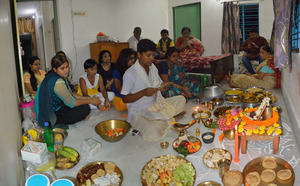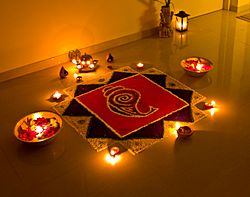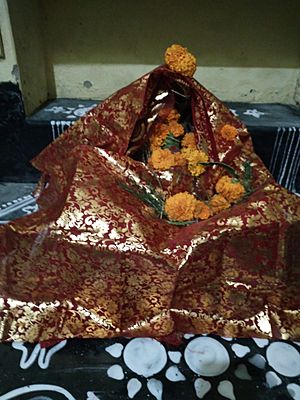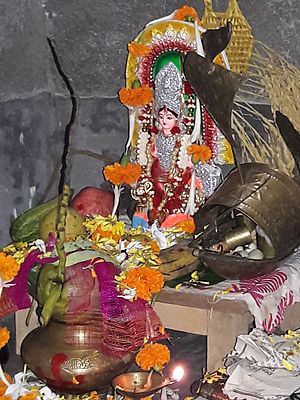Lakshmi Puja facts for kids
Quick facts for kids Lakshmi Pooja |
|
|---|---|
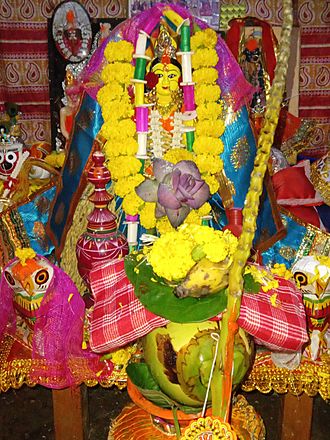
Lakshmi puja in an Indian Home
|
|
| Observed by | Hindus |
| Type | Hindu |
| Date | [[ | Lua error in Module:Wd at line 1575: attempt to index field 'wikibase' (a nil value). ]] māsa (amānta) / [[ | Lua error in Module:Wd at line 1575: attempt to index field 'wikibase' (a nil value). ]] māsa (purnimānta), Lua error in Module:Wd at line 1575: attempt to index field 'wikibase' (a nil value). pakṣa, [[ | Lua error in Module:Wd at line 1575: attempt to index field 'wikibase' (a nil value). ]] tithi |
| Frequency | annual |
| Related to | Diwali and Tihar |
Lakshmi Puja (Sanskrit: लक्ष्मी पूजा, IAST: Lakṣmī Pūjā), is a Hindu religious festival celebrated once in a year. It is celebrated on the Amavasya (new moon day) of Krishna Paksha (Dark fortnight). In the Vikram Samvat Hindu calendar it is celebrated in the month of Ashwin or Kartik. The puja is done on the third day of Tihar and is considered as the main event of Deepawali.
In Hinduism, Lakshmi is goddess of wealth and lord Vishnu's wife. It is believed that in this day she visits her followers and give them gifts and blessings. To welcome the Goddess, people clean their houses and make it bright with lights. They also prepare good food and sweets for offerings.
Contents
Celebrations
In India
Lakshmi is believed to roam the earth on the night of Lakshmi Pooja. On the evening of Lakshmi Pooja, people open their doors and windows to welcome Lakshmi, and place diya lights on their windowsills and balcony ledges to invite her in.
People wear new clothes or their best outfits as the evening approaches. Then diyas are lit, pujas are offered to Lakshmi, and to one or more additional deities depending on the region of India; typically Ganesha, Saraswati, and Kubera. Lakshmi symbolises wealth and prosperity, and her blessings are invoked for a good year ahead.
On this day, the mothers, who work hard all year, are recognized by the family. Mothers are seen to embody a part of Lakshmi, the good fortune and prosperity of the household. Small earthenware lamps filled with oil are lighted and placed in rows by some Hindus along the parapets of temples and houses. Some set diyas adrift on rivers and streams. Important relationships and friendships are also recognized during the day, by visiting relatives and friends, exchanging gifts and sweets.
It is popularly believed that Lakshmi likes cleanliness and will visit the cleanest house first. Hence, the broom is worshipped with offerings of haldi (turmeric) and sindoor (vermilion) on this day. Lakshmi Puja consists of a combined puja of five deities: Ganesha is worshipped at the beginning of every auspicious act as Vighneshvara; goddess Lakshmi is worshipped in her three forms; Mahalakshmi the goddess of wealth and money, Mahasaraswati the goddess of books and learning, and Mahakali. Kubera the treasurer of the gods is also worshipped.
The most auspicious time for the puja is decided when “amavasya tithi” prevails during “pradosh kaal” or the evening time. On this day, the sun enters its second course and passes the constellation Libra, which is represented by the balance or scale. Hence, the sign of Libra is believed to suggest the balancing and closing of account books.
After the puja, people go outside and celebrate by lighting up fireworks. The children enjoy sparklers and variety of small fireworks, while adults enjoy playing with ground chakra, Vishnu chakra, flowerpots (anaar), sutli bomb, chocolate bomb, rockets and bigger fireworks. The fireworks signify celebration of Diwalias well a way to chase away evil spirits. After fireworks, people head back to a family feast, conversations and mithai (sweets, desserts). People also perform vaibhava Lakshmi vrat for only one day it is believed that doing vrat on Diwali gives the blessings of vrat doing it for 21 times. Vaibhavalakshmi Vrat (Pious Observance & Worship of Laxmi) is also celebrated in many parts of India in the month of Margashirsha (the ninth month of Hindu Calendar) every Friday. Vaibhav means “Prosperity and Wealth” and hence Goddess Vaibhavalakshmi is believed to protect the devotees from misfortunes and grant them grace, happiness, wealth and prosperity.
Vaibhavalakshmi Poojan (Worship) is held at Juinagar, Maharashtra, India by Sadguru Shree Aniruddha Upasana Trust (Mumbai, India) every year with great enthusiasm. Thousands of devotees participate in this poojan and carry out the rituals with discipline and in harmony.
In Bengal, the goddess Lakshmi is worshipped five days after Vijaya Dashami on the full moon day of Sharada. This is known as Kojagori Lokkhi Pujo (কোজাগরী লক্ষ্মী পূজা) in Bengali. On this day generally, the goddess is worshipped at night. She is also worshipped in the form of banana trees (কলা বউ), designed clay cover of utensils (সরা), accompanied by a small boat containing five drums. She is also worshipped on the eve of Diwali which is commonly known as Dipanwita Lokkhi Puja (দীপান্বিতা লক্ষ্মী পুজো) or Alakshmi Viday (Leaving of Alakshmi). The goddess is also worshipped in the month of Bhadra (August–September) on Thursdays. She is worshipped as rice put into a utensil (হাঁড়ি) which is changed annually. This worship is also practiced in the month of Poush (December–January).
In Assam , Lakshmi/Lakkhi puja (লক্ষ্মী পূজা) is celebrated five days after Vijoya Doshomi. Family members participates in decorating home entrances to welcome Goddess Lakshmi. Prasad usually includes sweets, moong/gram , fruits etc
In Nepal
Lakshmi Puja is celebrated as a part of Tihar, a second national festival of Nepal after Dashain. In Nepal, it is celebrated for five days, which include Kag (crow) Tihar; Kukur (dog) Tihar; Gai (cow) Tihar in the morning and Laxmi pooja at night; Maha puja (self puja); Goru (Ox and Bull) Tihar and Gobardhan Puja; and finally, Bhai Tika (Bhai dhooj)—respectively the first, second, third, fourth and fifth days.
On Lakshmi Puja in Nepal, people buy gold and silver, precious gemstones, new utensils of copper, brass and bronze as a sign of good luck, prosperity, money and wealth. These are then used to worship Lakshmi at night. Nepalese people perform this worship at a place cleansed with holy water, cow dung and red mud; they light the whole house with candles and lamps. From Lakshmi Puja, Deusi and Bhailo is played by gathering with friends.
The Puja
In the beginning of the puja, the houses are cleaned and a rangoli is drawn at the doorstep to welcome Goddess Lakshmi.
Procedure
Before beginning the puja, Hindus consider it important to cleanse and purify the space where the Puja is being carried out. For this, "Guggal" or Loban (Benzoin) is lighted using either coal or dried pancakes made of cow-dung. Its incense armotic fumes are considered to purify the atmosphere. However instead, Readmade Dhoop Cones brought from the market are also used.
Once the place is smoked and cleansed, the puja begins by laying down a piece of new cloth on a raised platform. Handfuls of grains are sprayed in the centre of the cloth and a kalasha made of gold, silver, or copper is placed on top. Three-quarters of the kalasha is filled with water and betel nut, a flower, a coin, and a few rice grains are added to it. Five kinds of leaves are arranged (if a specified species is not available, leaves from a mango tree are used) and a small dish filled with rice grains is placed on the kalasha. A lotus is drawn over the rice grains with turmeric powder and the idol of Goddess Lakshmi is placed over the top of the kalasha, and coins are placed around it.
The idol of Lord Ganesha is placed in front of the kalasha, on the right-hand side pointing towards the south-west. Ink and business account books of the worshippers are kept on the platform. Specially blended oils made for puja are used with its ingredients varying, depending on the deity it's being offered to. A "Panchmukhi Diya" (Five faced lamp) accommodating 5 wicks are lit for this purpose. A special lamp is then lit in front of Lord Ganesha.
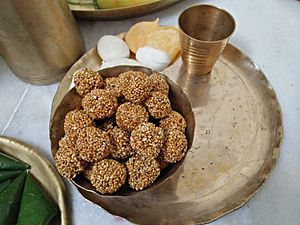
The puja begins by offering turmeric, kumkuma and flowers to the Goddess Lakshmi. Then haldi, kumkum, and flowers are offered to the water, later used for the puja. The river goddess Saraswati is invoked to become part of that water. Goddess Lakshmi is worshipped and invoked by reciting Vedic mantras, hymns and prayers addressed to her. Her idol is placed in a plate and is bathed with panchamrita (a mixture of milk, curd, ghee or clarified butter, honey, and sugar) and then with water containing a gold ornament or a pearl. Her idol is cleaned and placed back on the kalasha. A special lamp is then lit in front of Goddess Lakshmi.
Offerings of sandal paste, saffron paste, garland of cotton beads or flowers, ittar (perfume), turmeric, kumkum, abir, and gulal are then made to the Goddess Lakshmi. Flowers and garlands, such as Lotus, Marigold, Rose, Chrysanthemum and leaves of Bael (wood apple tree) are also offered. An incense stick is lit and dhoop is given to her. An offering of sweets, coconut, fruits, and tambul is made later. Puffed rice and batasha (varieties of Indian sweets) are placed near the idol. Puffed rice, batasha, coriander seeds, and cumin seeds are poured or offered to her idol.
In villages, a pot made of bamboo-canes measuring the paddy known as Nana' is filled up to the brink with freshly harvest paddy. Rice and lentils are also kept with the paddy. The `Mana' is the symbol of Mahalakshmi. Adoration of the Goddess is done by offering fruits, coconut, banana, doob-grass, amla, curd, turmeric, flowers, incense etc. It is customary to read out the holy book, the Eulogy, “Lakshmi Puran” while performing the pooja.
A Swastika symbol is also then drawn on the safe or vault in which the devotee keeps their valuables and it is worshipped as a symbol of Lord Kubera.
Towards the end of the ritual, Aarti is performed which is dedicated to Goddess Lakshmi. The Aarti is accompanied by a small bell and is performed in a silent and sublime atmosphere. Lakshmi Pooja is also celebrated in Indo-China.


